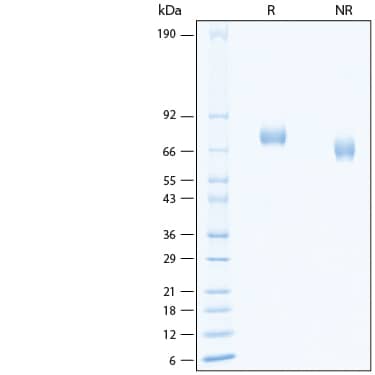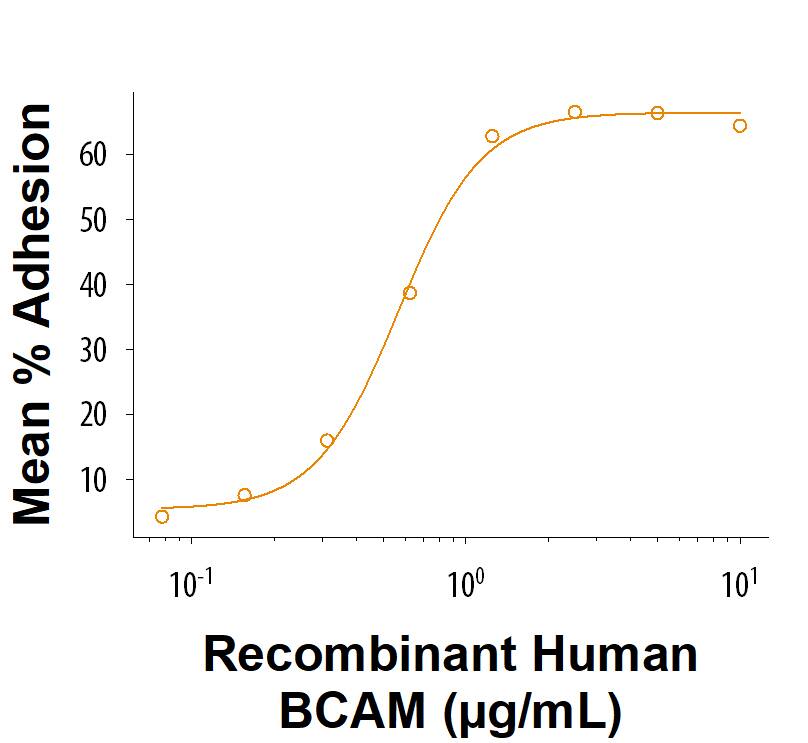Recombinant Human BCAM His-tag Protein, CF
R&D Systems, part of Bio-Techne | Catalog # 11173-BC

Key Product Details
Product Specifications
Source
Human embryonic kidney cell, HEK293-derived human BCAM protein
Glu32-Ala547, with a C-terminal 6-His tag
Glu32-Ala547, with a C-terminal 6-His tag
Purity
>95%, by SDS-PAGE visualized with Silver Staining and quantitative densitometry by Coomassie® Blue Staining.
Endotoxin Level
<0.10 EU per 1 μg of the protein by the LAL method.
N-terminal Sequence Analysis
Glu32
Predicted Molecular Mass
57 kDa
SDS-PAGE
67-82 kDa, under reducing conditions.
Activity
Measured by the ability of the immobilized protein to support the adhesion of TE-85 human osteogenic sarcoma cells.
The ED50 for this effect is 0.250-3.00 μg/mL.
The ED50 for this effect is 0.250-3.00 μg/mL.
Scientific Data Images for Recombinant Human BCAM His-tag Protein, CF
Recombinant Human BCAM His-tag Protein Bioactivity.
Recombinant Human BCAM His-tag Protein (Catalog # 11173-BC) supports the adhesion TE‑85 human osteogenic sarcoma cells. The ED50 for this effect is 0.250-3.00 µg/mL.Recombinant Human BCAM His-tag Protein SDS-PAGE.
2 μg/lane of Recombinant Human BCAM His-tag Protein (Catalog # 11173-BC) was resolved with SDS-PAGE under reducing (R) and non-reducing (NR) conditions and visualized by Coomassie® Blue staining, showing bands at 67-82 kDa.Formulation, Preparation and Storage
11173-BC
| Formulation | Supplied as a 0.2 μm filtered solution in PBS with Trehalose. |
| Shipping | The product is shipped with dry ice or equivalent. Upon receipt, store it immediately at the temperature recommended below. |
| Stability & Storage | Use a manual defrost freezer and avoid repeated freeze-thaw cycles.
|
Background: BCAM
References
- Rahuel, C. et al. (1996) Blood 88:1865.
- Vainionpaa, N. et al. (2006) Am. J. Physiol. Cell Physiol. 290:C764.
- El Nemer, W. et al. (1997) Blood 89:4608.
- El Nemer, W. et al. (1999) J. Biol. Chem. 274:31903.
- Schon, M. et al. (2000) J. Invest. Dermatol. 115:1047.
- Rahuel, C. et al. (2008) Am. J. Physiol. Renal Physiol. 294:F393.
- Rettig, W.J. et al. (1986) Cancer Res. 46:6406.
- Nishimune, H. et al. (2008) J. Cell Biol. 182:1201.
- Kikkawa, Y. et al. (2007) J. Biol. Chem. 282:14853.
- El Nemer, W. et al. (2001) J Biol Chem 276:23757.
- Eyler, C.E. and Telen, M.J. (2006) Transfusion. 46(4).
- Klei, TRL. et al. (2018) Blood Adv. 2:14.
- Guadall, A. et al. (2019). J. Biol. Chem. 294:14911.
- Chang, H.Y. et al. (2017) J. Biomed Sci 24:61.
- Kikkawa, Y. et al. (2013) J. Biol. Chem. 288:30990.
Long Name
Basal Cell Adhesion Molecule
Alternate Names
CD239
Gene Symbol
BCAM
UniProt
Additional BCAM Products
Product Documents for Recombinant Human BCAM His-tag Protein, CF
Product Specific Notices for Recombinant Human BCAM His-tag Protein, CF
For research use only
